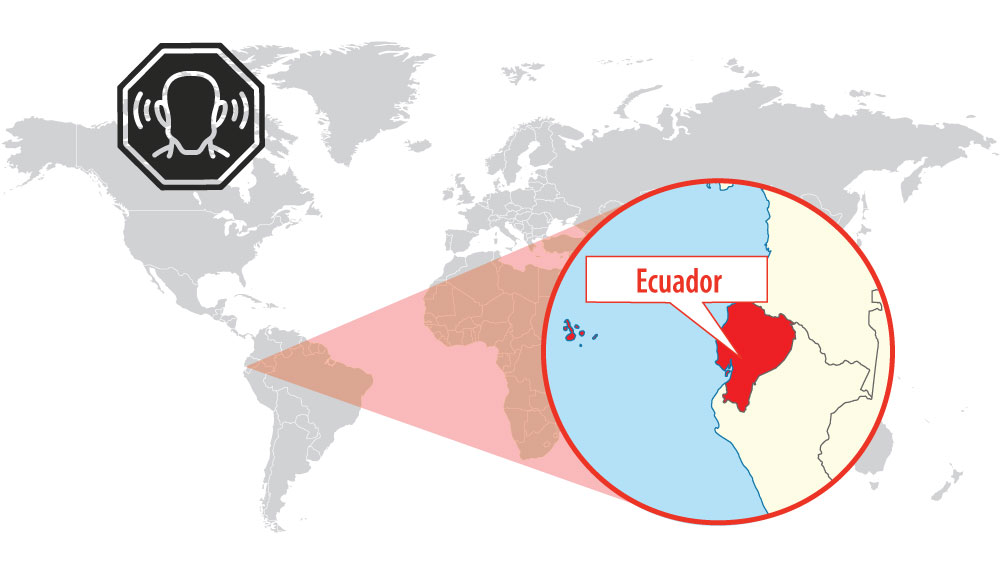Home / Success Stories / Libelium helps to reduce noise pollution in the city of Cuenca (Ecuador)
The installation of seven Plug & Sense! Smart Cities PRO with Noise Level Sensor allows the creation of a noise map with the highest sound pressure level.
The citizens of the Ecuadorian city had been complaining about the excessive noise in their streets for some time. Platforms such as “Cuenca without noise” have repeatedly warned about exceeding the legal levels of decibels in some areas and demand smart solutions to make their city more livable and healthy.
Several local institutions joined forces to make it real using Libelium technology.
Location of Cuenca (Ecuador)
Noise pollution is a public health problem. The population exposed to a noise level above 65 decibels develops a higher rate in 20% of heart attacks in the short term (Cohort Study of the German Federal Environment Agency). According to the WHO, the excessive noise pollution seriously harms human health and interferes with people’s daily activities at school, at work, at home and during leisure time. It can disturb sleep, cause cardiovascular and psychophysiological effects, reduce productivity and provoke annoyance responses and changes in social behaviour.
The cost of damage caused by the noise generated by road and rail traffic was recently estimated at €40 billion only in the EU (0.4 % of the GDP).
But, how loud is too loud? The level allowed in the residential areas in Ecuador is 55 decibels from 07:00 to 21:00 and 45 decibels from 21:01 to 06:59. While on the industrial floor, the noise level maximum is 75 decibels during the day and 65 dB at night.
Diagram of the installation
In this project, the Institute of Sectional Regime Studies of Ecuador (IERSE) of the University of Azuay, on request of the Council’s Environmental Control Commission, installed seven Libelium Plug&Sense! Smart Cities PRO nodes in different places of the city of Cuenca with the following sensors:
The points where the sensors were placed are:
Noise Level Sensor dashboard measured by IERSE
There are a wide variety of environmental noise sources. Industrials, traffic, street ads, alarms or works are the more common.
The University of Azuay already measured out 31 strategic points of the city once a year within the project “Evaluation of noise emissions in the city of Cuenca and noise map, with sound level meter”. To complement this information with real-time data and thus create a more complete noise map, they installed the Noise Level Sensor of Libelium to watch the behaviour of acoustic levels throughout the day.
For the election of these seven points, they were based on the data of complaints that citizens sent to the Commission of Environmental Management (Comisión de Gestión Ambiental, CGA). Those seven locations were the ones that had the highest number of sound problems.
Technician installing Libelium Noise Level Sensor
The members of the IERSE did comparative tests of the Libelium noise level sensor with a certified and calibrated sound level meter to verify that the measurements delivered had high precision and, therefore, can be considered as a reference.
The information collected by the sensors is sent every 10 minutes via 4G and stored on the University of Azuay servers. This allows continuous measurement of noise without excessive expenditure of resources. These data are public and can be viewed through their website in real-time.
“We have an efficient tool to capture important noise information and disseminate it to the general public, including decision-makers, who can track those sectors where high noise emissions are presented. This allows the intervention and better management of the behaviour of the city,” comment from IERSE.
The data compiled help to the Council of Cuenca to make decisions and design new regulations since it has the competence of the integral management of the environment that includes prevention, control and sanction of activities that motivate it.
This plan also involves citizens as an active part of improving the quality of life in the city.
Libelium Noise Level Sensor
Want to receive this and more IoT news directly to your email?
🔔 Subscribe to our newsletter and don’t miss anything!
You will learn about IoT and how it helps to make the world a more sustainable and efficient place.
This case study helps to achieve the following Sustainable Development Goals:
![]()
![]()
![]()
More info:
References:
Stay up to date in IoT!
Sign up to our newsletter and receive the latest, exciting news.
More than 18 years of experience in IoT support us.


















© Libelium Comunicaciones Distribuidas S.L. | Terms And Conditions | Privacy Policy | Cookies Policy | Security Policy | Reporting Channel